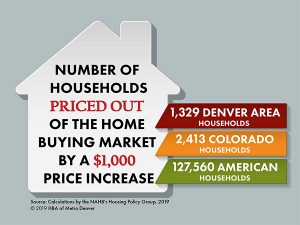Households Priced-Out by Higher House Prices and Interest Rates
 Increases in house prices and interest rates clearly have an impact on housing affordability. Often, stakeholders are interested in increases due to changes in government regulation. NAHB’s “priced-out” estimates provides a convenient way of putting these changes in context. The following overview summarizes the full article on HousingEconomics.com.
Increases in house prices and interest rates clearly have an impact on housing affordability. Often, stakeholders are interested in increases due to changes in government regulation. NAHB’s “priced-out” estimates provides a convenient way of putting these changes in context. The following overview summarizes the full article on HousingEconomics.com.
Price Increases
NAHB’s latest estimates show that nationally, a $1,000 increase in the price of a median-priced new home will price 127,560 U.S. households out of the market. Based on their incomes and standard underwriting criteria, each of these households would be able to qualify for a mortgage to purchase the home before the price increase, but not afterward.
Builder Costs and Home Prices
A related issue is the difference between builder costs and the final price of a new home. When government-imposed fees, changes in regulations, or other factors increase costs for a builder or developer, the final price of the home for the buyers will usually go up by more than the increase in the costs, as related costs, such as financing and broker commissions, also rise.
NAHB estimates that these add-on charges range from zero percent if a fee is imposed directly on buyers, to 40 percent if cost is incurred when applying for site development approval.
Interest Rate Increases
Prospective home buyers are also adversely affected when interest rates rise. NAHB’s priced-out estimates show that, depending on the starting rate, a quarter-point increase in the rate on a 30-year fixed-rate mortgage can price over one million U.S. households out of the market for the median-priced new home. Read the full article on NAHB’s priced-out estimates for 2019 on HousingEconomics.com.
